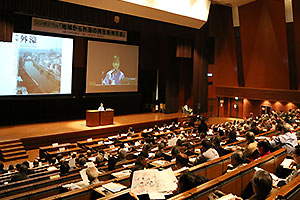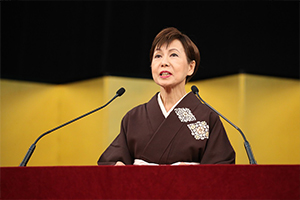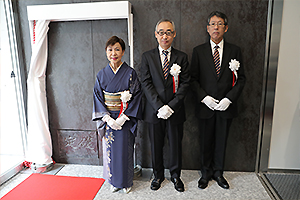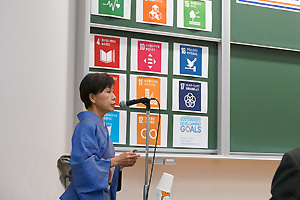March 31 (Sunday)
Appeared on Sunday Morning.
On the escalating Japan-Korea issue, he spoke about the importance of how to recognize the issue of war from a higher perspective, without getting caught up in political use or media sensationalism. On the issue of China's One Belt, One Road beginning to affect Europe, he spoke about the conversion of ports in developing countries into military bases that have become unable to repay their debts in the name of "aid. The issue of the "missing foreign students" at Tokyo University of Social Welfare, the way the revised Immigration Control Law, which goes into effect tomorrow, is being implemented, and the inclination toward Israeli nationalism are all moves that run counter to diversity. In particular, the acceptance of foreign students by universities should be based on the quality of education, not on numerical targets.
It was interesting that before the program began, Hiroshi Sekiguchi, the host of the program, asked the commentators if they had any opinions about the change of the Japanese government, and they came out one after another, so he stopped asking for comments because he was running out of time. This is an issue that should be discussed slowly and thoroughly in the future.
Thursday, March 28
I attended the Tokyo Metropolitan Government's "TOKYO Conference for Women and Men to Shine" as a representative of Dalian.
I returned to the university and exchanged opinions with the student center. I heard about the activities of the students working at the university's volunteer center. They are very energetic. The area of activity extends from Kumamoto and Iwate prefectures to Machida City Aihara, Koganei City, and Chiyoda Ward, where the campuses are located. In Iwate Prefecture, the role has shifted from providing material support to connecting people with each other. There seems to be a deep consideration and understanding of the community. Activities in Aihara are also becoming more diverse and ongoing, and as we have been reporting on our website, the scope of our activities is very broad. Volunteer circles have been active for a long time, and next year will mark the 10th anniversary of the establishment of the Volunteer Center, which will link information on these activities. It is quite understandable that they would like to compile some kind of summary to disseminate their past activities. We would like to think about this together.
Wednesday, March 27
We held a meeting of the Executive Trustee and held four different Executive Trustee roundtable meetings.
An agreement signing ceremony was held with Hokkai-Gakuen University. This is a student exchange agreement. This agreement will allow students to come and go between Hokkaido and Okinawa.
March 26 (Tuesday)
A presentation of the "Proposal for the Future of Tama Campus" was held at the Tama Campus (connected to the Ichigaya Campus remotely). Faculty members made 16 presentations and engaged in lively discussions, focusing on the realization of a 24-hour campus, classroom design to promote active learning, construction of a campus that integrates academic and residential facilities as a new sports hub, establishment of media labs and media workshops for education in collaboration with industry and government, and integration of the administrative organizations of the faculties, We heard concrete proposals that gave us a sense of the feasibility of the project. The Tama Campus restructuring is finally becoming a concrete plan.
March 25 (Monday)
A symposium entitled "Considering the Regeneration of the Outer Moat from the Local Community," organized by the Outer Moat Regeneration Roundtable and co-sponsored by TUAT and the Tokyo University of Science, was held at Tama University. With the Roundtable as a pillar, cooperation among schools, universities, local administration, and citizens is expanding with the aim of revitalizing the water and culture of the outer moat. Working at the center of this effort has been the Hosei University Research Center for Eco-regional Design, established in 2004; in 2013, the Outer Moat Citizens' School was created, and in 2016, the Outer Moat Revitalization Roundtable was formed.
On this day, following my lecture titled "The Potential of Outer Moat Culture" and a lecture by Tokyo University of Science President Yoichiro Matsumoto titled "Outer Moat and Kagurazaka in the Global City of Tokyo" and an explanation of the "Outer Moat Restoration Charter" by Hosei University Professor Tsuneaki Fukui, the symposium was attended by Hidenobu Jinnai, Hosei University Specially Appointed Professor, Motomu Uno, Tokyo University of Science Professor, and Kagurazaka Culture Promotion Club, Kimiko Iida, President of Fujimi Area Town Association Yukihiko Takanashi, Principal of Miwada Gakuen Tamami Yoshida, and Yasunori Tamaki of KADOKAWA, a local company, participated in a panel discussion.
The year 2036 is the 400th anniversary of the opening of the outer moat. The "Outer Moat Four Seasons Picture Scroll" drawn in the vision is very enjoyable. Stagnant water becomes flowing water by connecting with the Tama River. The Ushigome Mitsuke Gate in Iidabashi will be rebuilt. Boat transportation will be revived. And the "Halloween" of the past will become "Edo Win" and everyone will be dressed up in kimono on the day of the Halloween. The outer moat will be opened in the near future, while remaining close to the water and scenery of the Edo period.

Nineteen Hatamoto residences were located on the Hosei University site. The neighboring Tokyo Telecommunications Hospital was the upper house of the Itakura family of the Fukushima domain. Up on Kagurazaka, on the other side of the outer moat, the Ushigome plateau spread out, and it was packed with large and small residences of bannermen and samurai of the shogunate. This does not mean that it was a samurai culture area. The samurai here, along with the townspeople, created ukiyoe and kyoka (comic poems), which have remained as representative of Edo culture to this day, their future. The outer moat network is a cultural and environmental movement of citizens, not one guided by the government, but one that should be realized one by one with the involvement of many organizations.
March 24 (Sunday)
The 2018 degree conferment ceremony was held. The day before the ceremony was very cold due to the cold flowers, but on this day the sun finally warmed up and it was a spring-like degree conferment ceremony. The scenery inside the Budokan is becoming more gorgeous every year. It seems that more and more students are wearing kimonos and hakama. As in previous years, we also attended a party to celebrate the graduation of international students who studied at our university and those who have been sent to study abroad. Congratulations to all graduates!

March 23 (Saturday)
The 13th Farewell Party for Athletic Association Graduates" was held by the Hoyu Athletic Association, a partner organization of the Hosei University Alumni Association. Awards were presented not only to students who achieved remarkable results in sports this year, but also for their academic achievements and contributions. These students understand the meaning of teamwork. I told them, "What you have learned is not to follow instructions, but to think and decide for yourselves. I hope you will make use of this ability. I have no doubt that you will lead society in the right direction.
March 22 (Friday)
The deans' meeting was held for the last time this academic year. At the end of the academic year, almost half of the deans will be replaced. It is somewhat sad. The dean's meeting can be a heated discussion, but that is why we share the same issues. I understand the difficult position of deans who are caught between the faculty council and the university. You have all done your duty very well. I am grateful to them. I am particularly sad to see Faculty of Lifelong Learning and Career Studies Emiko Takeishi, who for the past two years has been the only female dean of the College Faculty of Lifelong Learning and Career Studies and has been responsible for promoting diversity, go, but I am sure we will be able to work together in other ways in the future.
March 20 (Wednesday)
The Executive Trustee Meeting was held.
This year marks the 100th anniversary of the Ohara Institute of Social Research, which was founded in Osaka in 1919 by Magosaburo Ohara and merged with Hosei University in 1949. To commemorate this event, a symposium was held on this day to celebrate the 100th anniversary of its founding and the 70th anniversary of the merger with Hosei University. The Ohara Institute of Social Problems is Japan's oldest private research institute in the field of social sciences. Several projects are planned for the future, including a centennial history compilation project. I am very much looking forward to it.
March 19 (Tuesday)
There was a meeting of the Trustee and a general meeting of the Japan Association of Private Universities. The report, "The New Era of Employment and Recruitment and University Education," which I compiled as the chairperson of the Expanded Policy Research Section Conference, was adopted.
Mr. Naoki Ito, editor of Shueisha Shinsho, and Ms. Chiwako Miyauchi, writer, visited the room. This was the final installment of their discussion of Michiko Ishimure's essay. Since I could share my words with Ms. Miyauchi, I was confident that we could make a good book.
March 16 (Saturday)
The ceremony was held to celebrate the completion of the reconstruction of the 55th and 58th buildings/Ouchiyama School Building. After the ceremony, we toured the school building. It is a shame that the 55/58 building will no longer be there, but we are grateful to Mr. Hiroshi Oe for utilizing some of his designs. I am grateful to the construction workers who were able to finish in time during the difficult pre-Olympic period.
In the afternoon, the annual "Mass Communication Orange Club" was held, which is composed of members of the mass media who have graduated from Hosei University or current students who have received job offers. I gave a speech, informing them of the completion of the Ouchiyama School Building.

Friday, March 15
Attended a meeting of the board of directors of an outside company. Back at the university, I recorded a video message for new students.
Mr. Yusuke Suzumura, a long-time substitute lecturer for my course on Comparative Culture in Faculty of Social Sciences and who has also made a great contribution to our Institute for Global Japanese Studies, has left Hosei University to become a full-time faculty member at another university. He left Hosei University to start up the Institute for International Japanese Studies at another university. Therefore, we held a farewell party to celebrate his departure. Mr. Suzumura is a well-known baseball history researcher and author. He has presented at academic conferences and lectured in English, and taught for a long time in the exchange student program (ESOP) at TUFS. He is also fluent in German and French and is a flute player. It is with great regret that he has decided to leave TUFS. We would like to continue to cooperate with him in Japanology.
March 14 (Thursday)
At the Kanda Myojin Cultural Exchange Center, which opened last December, a series of lectures on Kanda Myojin and Edo Tokyo Culture by researchers from the Edo Tokyo Research Center of Hosei University began today. I gave the first lecture, "Mastering Edo. There will be seven more lectures from now until July. Information is available at the Edo Tokyo Research Center.
In the afternoon, we returned to the University for the University-wide Quality Assurance Meeting, followed by the HOSEI2030 Promotion Headquarters Meeting.
After that, Mr. Munetaka Shashiki, President of Nippon Steel & Sumikin Solutions, who is responsible for equipment and software solutions for the University, as well as the Vice President, Business Manager, and Deputy Business Manager visited the room and exchanged opinions on future proposals and other issues.
March 13 (Wed)
The Executive Trustee and the Trustee met. The LU Fundraising Committee also met afterwards.
March 12 (Tuesday)
A university-wide public relations strategy meeting was held. In the afternoon, the LU Foundation held a meeting with Meiji University and Kansai University to discuss a new event to be held under the theme of "Japanese Studies" based on the three-university agreement. It is always a great pleasure for me to meet with President Keiichiro Tsuchiya of Meiji University and President Keiji Shibai of Kansai University.
March 11 (Monday)
Preparatory committee meeting for the opening of the museum. Meeting of the Amagi School Principals' Conference.
March 9 (Saturday)
The townscape of Sawara, with the river at its center, is one of Japan's cultural heritage sites that retain the atmosphere of the Edo period. The preservation of this townscape and its festivals is one of the reasons why Hosei University's Edo/Tokyo Research Center responded to the request to speak here, but there are other reasons as well. This is because Edo culture was created in the midst of the mobility that connected the whole country at that time. The Tone River system supported the East Coastal Route when it was connected to the West Coastal Route and the East Coastal Route was connected to the West Coastal Route. Sawara was located in the basin of the river extending from the Tone River and was one of the distribution centers. In my lecture, I talked about the influence of this network on Edo culture.
There was another reason for my visit to Sawara. Ino Tadataka, who accomplished the surveying of all of Japan during the Edo period, was the feudal lord responsible for Sawara's autonomy. The village became a distribution center as a river bank. This brought a large number of merchants into the village. Tadataka never closed the village, but protected it by opening it to the outside world. He did not give in to the pressure from the shogunate, which wanted him to form a group of riverfront wholesale dealers and collect transportation fees, but instead continued to negotiate and trade freely, using the records kept by the Ino family. All of these experiences led to the surveying business that followed.

March 8 (Friday)
Meeting of heads of schools. Then, a meeting of the Policy Research Division of the Japan Association of Private Universities to discuss employment and recruitment issues. After the meeting, he moved to Sawara, Katori City, Chiba Prefecture. He was scheduled to give a lecture and symposium at Hosei University's Edo/Tokyo Research Center on the following day. On this day, we had French cuisine and wine at a restaurant in an old private house in Sawara, and stayed at another old private house. It was a modern transformation of a tradition that was also practiced by the people of the Edo period.
March 7 (Thursday)
We had a meeting of the HOSEI 2030 Promotion Headquarters. After that, the regular "Global Strategy Headquarters Meeting" and the Dean's Meeting were held. I asked the Vice President to act as the facilitator and left the meeting. I was invited by Dr. Juichi Yamaguchi, President of Kyoto University President President of the Science Council of Japan, to speak at the "Industry-Academia Collaboration for Society 5.0" organized by the Science Council of Japan and Keidanren. I gave a lecture on the theme of "Industry-University Collaboration in the Future: Perspectives from Private Universities" and participated in a panel discussion.
Society 5.0 means the fifth super-smart society after the hunting society, agricultural society, industrial society, and information society. This event was held to discuss how industry and universities should share a vision and work together to create value in order to make "Society 5.0" a society that solves social issues and creates value. Mr. Masao Oka, President of Yamaguchi University, spoke from the perspective of local national universities, and Mr. Jinichi Igarashi, Chairman of the Industry-Academia-Government Collaboration Promotion Subcommittee of the Keidanren Committee on Future Industry and Technology, spoke from the perspective of the industrial world. The panel discussion was led by Juichi Yamaguchi and joined by Izumi Kobayashi, Vice President of Keizai Doyukai (Japan Association of Corporate Executives), and Denji Kobayashi, Trustee and Vice President Osaka University.
Common perceptions and measures regarding "Society 5.0" are still centered on scientific and technological research, and there is a widespread belief that IoT, drones, and robots will solve social issues. That cannot be true. A super-smart society can only relegate solutions such as reducing physical burdens to the Internet. Because it can do so, we need to deepen what only people can do in "other" areas. That research is just the beginning.
March 6 (Wed)
The Executive Trustee and Executive Trustee Roundtable Meeting were held.
This was followed by the annual "Supporting Members Gathering. Supporting members are those who donate large sums of money for the benefit of TUAT students. Most of them are alumni, but there are also current faculty members, as well as the companions of deceased alumni and deceased staff members who have also become supporters. The conversation is lively and it is a very enjoyable party every year. I always feel warmth when I remember your faces. Thank you very much.
March 5 (Tuesday)
The annual retirement party was held. There was a meeting of the Executive Trustee Japan Association of Private Colleges and Universities.
After that, we had a dialogue for HOSEI ONLINE, which is scheduled to be published on April 1. At my request, I invited novelist Kazuichi Iijima to participate. He is a graduate of the Faculty of Letters University of Tokyo. It seems that our two years of schooling overlapped. Since he started writing novels, he has won countless awards. I have been reading his novels since "Hajimatoki" was published in 2000. I also like "Kogane Tabikaze," "Dasei Maeya," and "Gubin Doko no Shima," but especially "Hoshi Yoru Koso," which was published last year, is a great work that describes the Battle of Nagashino, the background to that battle, the Age of Exploration, Southeast Asian trade, Hideyoshi's invasion of Korea and its failure, and the start of the Korean mission in the Edo period. It depicts the senselessness and misery of war, and thoroughly takes the viewpoint of the side to be dominated. That is what makes it so wonderful. When I mentioned this to him, he humbly said, "I am a commoner. He was not the kind of person who spoke eloquently and eloquently about his thoughts. His quiet way of speaking, "I wanted to live in a way that only I can live," is very wonderful.
Mr. Toshiya Yoshimi, a sociologist and former Vice President University of Tokyo Vice President came to our office to discuss the possibility of collaboration between the Tokyo Cultural Resources Council, Hosei University, and the Edo Tokyo Research Center. I used to work with Mr. Yoshimi at various places in the past, including "Asahi Journal. It was a long time ago. The Tokyo Cultural Resource Council is involved in so many different activities that it is impossible to write about them all here, but it is very interesting to see how a city is revitalized not only by its hardware, but also by its people. Ms. Yasuko Yokoyama, Director of the Edo Tokyo Research Center, and Mr. Hidenobu Jinnai, former Director of the Center, were also present. The Edo Tokyo Research Center is a key branding element that can connect with many organizations outside the university.
Saturday, March 2
He went to Nagoya to give a lecture at the Nagoya International Center. Aichi and Shizuoka prefectures have been home to many working foreigners for decades. The first international center was established in Nagoya in 1984, and has been involved in a variety of activities, such as providing consultation services for foreigners, conducting exchange programs, and creating a town that is comfortable for foreigners to live in. His lecture on globalization in the Edo period was attended by a large number of people. I thought it was an important organization to lead various policies in Japan, where the number of working foreigners is expected to increase.

March 1 (Friday)
A symposium was held on "SDGs and University Education. In 2014, TUAT was selected for the "Super Global University Creation Support Program. The vision was "to create a global university that envisions a sustainable society from Japan, an advanced problem-solving nation. The mission of Hosei University is to contribute to the "creation of a sustainable global society" by solving the diverse challenges of the turbulent 21st century, and sustainability has been a consistent goal of the university. In the Hosei University Hosei University Charter, sustainability and diversity are also important goals of the university, and in 2016, the university made a "Diversity Declaration. These goals overlap with the 17 goals of the SDGs. In December of last year, we issued the President Statement on SDG initiatives, proposing the implementation of SDG seminars and symposiums, SDG certificate programs, and the development of SDG-themed courses. This symposium is the realization of that proposal.
Under the theme of "SDGs and University Education," we deepened our discussion on what is expected of university education from the different perspectives of the UN, industry, and universities. We heard and discussed the perspectives of the United Nations from Kaoru Nemoto, Director of the United Nations Information and Public Information Center, industry from Kenji Uno, Deputy Director of Research Division, Daiwa Institute of Research Ltd, overseas universities from Motoo Furuta, President of Japan-EU, and our university's educational activities from Akiko Yuge, Professor of Department of Global PoliticsFaculty of Law.
Since the SDGs are goals that are easy for corporations to work on, there is criticism from that perspective. I share the concern that the SDGs may become a tool for corporations, and that they may end up being a sop to the public. In fact, some companies seem to consider the SDGs as a tool for overseas expansion. However, global companies are not free to do whatever they want as long as they make a profit. It is important to be aware of this, and to curb the contradiction with the spirit of the SDGs, which can be pointed out from the outside. The Science Council of Japan is also engaged in activities to compare its research with the SDGs. Considering the possibility that research and corporate activities may target only war and economic development, it makes sense to set goals for the SDGs as a whole. It is important to note that the SDGs should not be (and should not be allowed to be) just a few convenient items, that only an attitude of realizing the overall goal should be taken as an endorsement, and that they should not fall down as a billboard.


